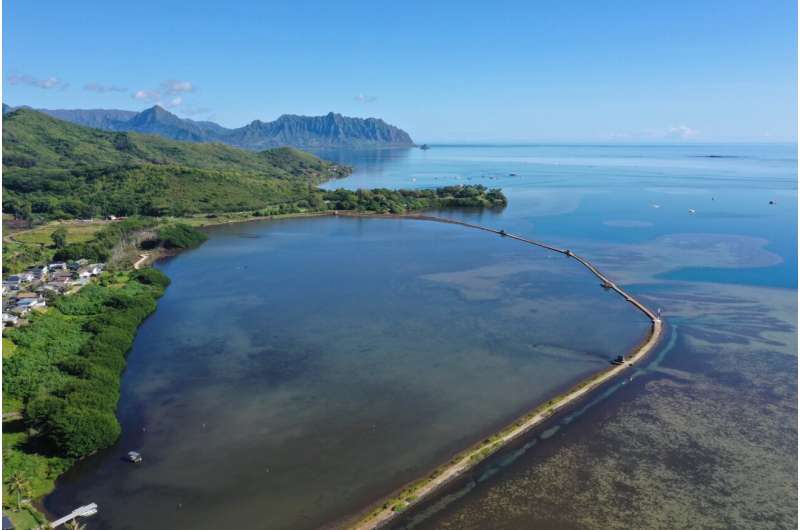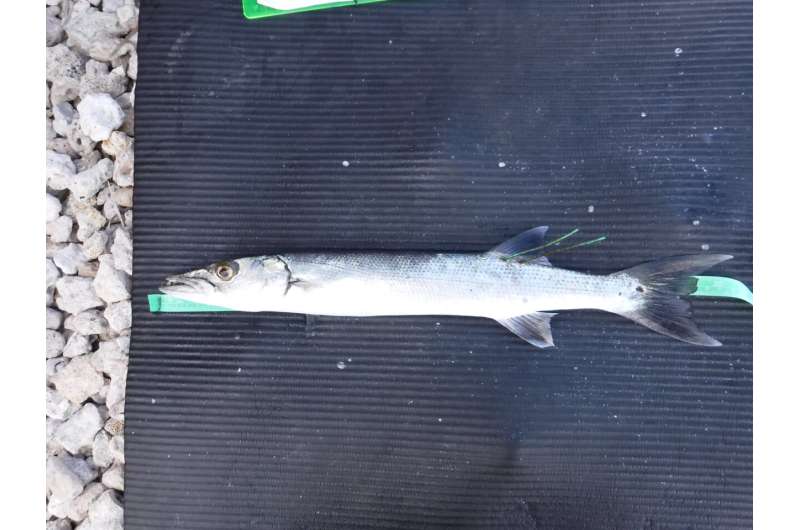Aerial view of He'eia Fishpond. Credit: UH / Paepae O Heʻeia
Jacks and barracuda in Heʻeia fishpond were found to feed on Australian mullet, an invasive species introduced to Oahu waters in the 1950s. This finding, published in Aquaculture, Fish, and Fisheries by researchers from the University of Hawaiʻi at Mānoa, University of California at Santa Barbara (UCSB), and Paepae O Heʻeia suggests that these native predatory fish may provide a form of biocontrol on populations of the invasive mullet species.
Traditional fishponds, called loko iʻa, were once common across coastal areas of the Hawaiian Islands and provided a sustainable and pragmatic solution to food security concerns for local communities for centuries. Fishpond management typically focused on the cultivation of mullet, moi, and awa which are plant-eating fish that thrived in fishpond environments. These desirable fishes would be eaten by fish like jacks and barracuda, which needed to be periodically removed from the fishpond. After invasive fish species were introduced to Hawaiian waters, they made their way into fishponds and altered fishpond marine food webs.
UH Mānoa's Hawaiʻi Institute of Marine Biology (HIMB) Associate Research Professor and study co-author Erik Franklin said the prominence of the invasive mullet in the predatory fish diets was unexpected.
"Our study showed that the introduction of invasive Australian mullet altered the diets of the native predatory fish in the fishpond which really expanded our understanding of the food web interactions in these systems," said Franklin. "The jacks and barracuda seemed to preferentially feed on the invasive mullet rather than native mullet and moi. This would help control the population of the invasive species which competes for resources with the native fish."
Kaku, or barracuda, are native predatory fish in the traditional Hawaiian Fishpond in He'eia on O'ahu, Hawai'i. Credit: University of Hawaii
Importance for Hawaiʻi
Hawaiian fishponds can be a tool to increase food security by producing seafood for local consumption. Over 80% of food consumed in Hawaiʻi is imported at a cost of nearly $3 billion annually. Economic analyses suggest that a small replacement of imported foods would generate substantial sales, earnings, state tax and employment for the seafood sector. In 2019, over 10 million tourists visited the Hawaiian Islands and placed an immense demand on food resources well beyond the needs of the 1.4 million residents.
Prior studies have found that tourists to Hawaiʻi from the continental U.S. are willing to pay more for locally-sourced foods while on vacation in the islands to help the state become a more sustainable tourism destination. A network of restored fishponds could help meet the demands for locally-produced foods.
"The restoration of functional Hawaiian fishponds represents a promising opportunity to increase local seafood production but there is still much to learn about the ecology and dynamics of fishpond communities," said lead author and UH Mānoa Marine Biology Graduate Program graduate student Anela Akiona, a Kamehameha Schools alumna. "A functional fishpond would contribute to enhanced island food security that can supplement catch from fisheries and other aquaculture operations."
Franklin said the research resulted in analyses of the abundance and prey of predatory fishes in the Heʻeia fishpond. The study used a tag-recapture experiment, genetic barcoding, stable isotope analysis, and statistical methods to assess the number of jacks and barracuda in Heeia fishpond and their diet composition.
More information: Anela K. Akiona et al, Predatory fish diets shift towards an invasive mullet in a traditional Hawaiian aquaculture system, Aquaculture, Fish and Fisheries (2022). DOI: 10.1002/aff2.68
Provided by University of Hawaii at Manoa

























